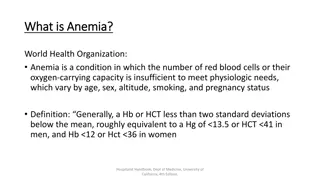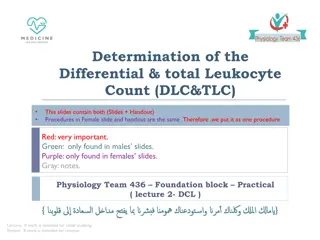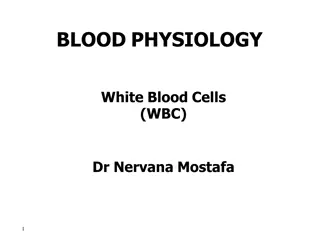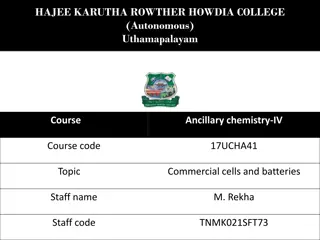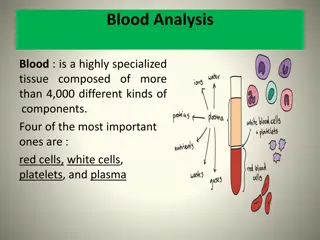Transfusion
Blood transfusion is a crucial medical procedure worldwide, with various components like packed red blood cells, plasma, platelets, and cryoprecipitate being utilized for efficient use. Differential centrifugation is employed for component preparation, ensuring precise separation of red blood cells,
2 views • 45 slides
Differential white blood cell count
Differential white blood cell count, also known as a leukocyte count, is a crucial test to determine the different types of white blood cells present in the blood. The cells are classified into granulocytes (neutrophils, eosinophils, basophils) and agranulocytes (lymphocytes, monocytes). Blood smear
3 views • 21 slides
Understanding How Diabetes Affects Blood Vessels
Diabetes can harm blood vessels, leading to complications due to high blood sugar levels. Hemoglobin A1c plays a crucial role in monitoring glucose control, with values above 6.5% indicating diabetes. Over time, high blood sugars can damage blood vessels, affecting blood flow and increasing the risk
1 views • 19 slides
Understanding White Blood Cells: Defense Mechanisms and Functions
White blood cells, specifically neutrophils and macrophages, play crucial roles in defending the body against infections. Neutrophils attack and destroy bacteria in the blood while macrophages, once matured in tissues, combat intratissue disease agents. These cells exhibit unique abilities such as d
7 views • 52 slides
Understanding Red Blood Cell (RBC) Count and Its Significance in Blood Health
Red blood cells, comprising nearly 45% of blood volume, play a crucial role in oxygen transport. The red blood cell count, measured as the number of cells per unit volume of blood, helps assess the adequacy of oxygen-carrying capacity. Normal values vary by age and gender. The experiment aims to det
8 views • 16 slides
Chronic Myeloid Leukemia
Chronic myeloid leukemia (CML), or chronic myelogenous leukemia, is a slow-growing form of cancer that affects the bone marrow and blood. Like acute myeloid leukemia, CML originates in the myeloid cells. When functioning properly, myeloid cells produce mature red blood cells, platelets and non-lymph
2 views • 7 slides
Understanding the Components of Blood for Better Health
Explore the main components of blood such as red blood cells, white blood cells, platelets, and plasma. Learn how these components function, their percentages in blood, and how they impact human health. Discover the importance of blood donation and how changes in blood composition can affect overall
2 views • 19 slides
Understanding Blood Groups and Their Significance
Human blood types are determined by specific antigens and antibodies present on red blood cells, influencing crucial aspects like blood transfusions and familial relationships in forensic medicine. The ABO system, with its four main blood types (A, B, AB, O), plays a vital role in categorizing blood
7 views • 14 slides
Bone Marrow Transplant Cost in India
The supple, fatty tissue found inside your bones is called bone marrow. The cells that make blood and platelets are found in bone marrow, which also produces billions of new blood cells daily.\nA bone marrow transplant (BMT) includes using healthy blood-forming stem cells to replace the patients' di
1 views • 2 slides
Understanding Blood Cells and Their Functions in the Circulatory System
Blood is comprised of cells and plasma that circulate within the closed circulatory system. The formed elements include erythrocytes, platelets, and leukocytes, each playing vital roles in oxygen transport, defense against infection, and nutrient distribution throughout the body. The hematocrit esti
2 views • 38 slides
Understanding White Blood Cells and Their Classification
White blood cells (WBCs), or leukocytes, are vital elements of the blood responsible for protecting the body against invading organisms. They are classified into granulocytes (neutrophils, eosinophils, basophils) and agranulocytes (monocytes, lymphocytes), each playing specific roles in the immune s
1 views • 28 slides
Understanding Differential Leucocyte Count for Blood Disorders
Differential Leucocyte Count (DLC) is crucial for diagnosing blood-related disorders by analyzing the distribution and morphology of white blood cells. Dr. Versha Prasad explains the significance, normal values, and various conditions like neutrophilia, lymphocytosis, monocytosis, and basophilia. Th
1 views • 15 slides
Understanding WBC Differential Count in Blood Analysis
WBC (white blood cell) count is essential in assessing a patient's health. A differential count helps determine the percentage of different types of white blood cells. This analysis can provide important insights into various health conditions like infections, allergies, and systemic illnesses. The
1 views • 9 slides
Understanding Coagulants, Anti-Coagulants, and Blood Components in Pharmaceuticals
Mrs. Sashmitha Samuel, an Associate Professor in the Department of Pharmaceutical Chemistry, delves into the importance of coagulants, anti-coagulants, and the components of blood. Blood, a vital fluid in the body, carries nutrients, oxygen, and helps remove waste products. Learn about the process o
1 views • 43 slides
Understanding Blood Cells and Transport Mechanisms
Your blood, consisting of red blood cells, white blood cells, platelets, and plasma, plays a crucial role in transporting substances like oxygen, nutrients, and waste products throughout your body. Red blood cells are specialized for oxygen transport due to their unique adaptations, while white bloo
2 views • 18 slides
Understanding White Blood Cell Count and Measurement Methods
White blood cell count measures the number of white blood cells in a specific volume of blood, indicating infection or disease progression. The normal range is 5000-11000 cells/cubic mm, varying with age. Methods include manual and electronic counting using specific instruments. Materials like antic
0 views • 14 slides
Understanding Anemia: Causes, Mechanisms, and Classifications
Anemia is a condition characterized by a deficiency in red blood cells or their oxygen-carrying capacity, impacting physiological needs. Causes include blood loss, decreased production, and destruction of red blood cells. There are various classifications such as acute and chronic blood loss anemia,
0 views • 19 slides
Understanding ABO Blood Grouping and Rh Groups
ABO blood grouping and Rh factor testing are crucial for blood transfusions and forensic medicine. The presence or absence of specific antigens and antibodies in human blood determines blood type. Genetic inheritance from parents establishes blood type, with codominance influencing offspring phenoty
0 views • 13 slides
Understanding Stem Cells and Their Applications
Stem cells are unique cells that have the potential to develop into various types of cells in the body. They play a crucial role in renewing and repairing tissues, offering hope for treating various medical conditions. While adult stem cells can differentiate into limited cell types, embryonic stem
0 views • 9 slides
Understanding White Fragility and Racism: Insights from "White Fragility: Why It's So Hard for White People to Talk About Racism" by Robin DiAngelo
Exploring the challenges white people face in discussing racism, "White Fragility" by Robin DiAngelo sheds light on the systemic issues shaping our lives. It emphasizes the need for white individuals to confront their role in upholding racism, strive for racial humility, and work towards interruptin
0 views • 13 slides
Understanding White Blood Cells and the Immune System
Explore the intricate details of white blood cells (WBCs), their types, functions, formation, and crucial role in defending the body against infections. Delve into the immune system, comprising barriers, cells, tissues, and organs that combat invaders, with a focus on innate and adaptive immunity. L
0 views • 65 slides
Understanding Leukopoiesis: The Development of White Blood Cells
Leukopoiesis is the process of white blood cell production, crucial for defending the body against foreign agents. Granulocytes and lymphocytes are key components, with granulocytes found in different locations like the bone marrow, blood, and tissues. The bone marrow pool plays a vital role in the
2 views • 23 slides
Understanding Blood Components and Their Administration
Effective blood transfusion therapy relies on the availability and proper administration of various blood components. Separating blood components allows for better patient care by matching transfusions to individual needs and avoiding unnecessary components. Different blood products like packed red
1 views • 27 slides
Understanding the Circulatory System: Functions and Components
The circulatory system, comprised of pulmonary and systemic circulation, plays a crucial role in transporting oxygen, nutrients, and waste products throughout the body. It consists of the heart, arteries, veins, and capillaries which work together to ensure proper circulation. Blood, the carrier of
0 views • 21 slides
Understanding Hematopoiesis and White Blood Cells in Blood Formation Process
The process of hematopoiesis involves the lifelong production, multiplication, and specialization of different blood cells in the bone marrow, starting with the stem cells. This process includes the differentiation and proliferation of various progenitor cells, regulated by hematopoietic growth fact
0 views • 27 slides
Versiti Blood Center of Illinois: Community Impact through Blood Drives
Versiti Blood Center of Illinois, a nonprofit organization, plays a vital role in healthcare by organizing blood drives to ensure a sufficient supply of blood for hospitals in the Chicagoland and Northwest Indiana area. Through employee engagement, community outreach, and raising awareness about the
0 views • 10 slides
Comparison of Eukaryotic and Prokaryotic Cells in Cell Biology
Cells are the fundamental units of life, but viruses are an exception as they lack cells. Eukaryotic cells have a defined nucleus with a nuclear membrane housing chromosomes, while prokaryotic cells lack a membrane-bound nucleus and other organelles. Eukaryotic cells are larger, containing membrane-
0 views • 9 slides
Understanding Differential and Total Leukocyte Count (DLC & TLC)
Differential and Total Leukocyte Count (DLC & TLC) is a crucial test that determines the percentage of different types of white blood cells in the total leukocyte population, aiding in diagnosing various disease processes. The test involves identifying and counting different types of white blood cel
0 views • 18 slides
Understanding Stem Cells and Cell Potency in Animal Cells
Stem cells play a crucial role in animal cells, offering the potential to differentiate into various cell types. Totipotent stem cells are the most versatile, capable of developing into any cell type in the embryo, including extra-embryonic cells. Pluripotent stem cells can give rise to all body cel
0 views • 22 slides
Understanding Complete Blood Count (CBC) Test
Complete Blood Count (CBC) is a panel of tests that evaluates different types of blood cells, including red blood cells, white blood cells, and platelets. CBC helps diagnose various blood disorders and monitor conditions that affect blood cells, such as anemia or infections. The test is ordered base
0 views • 20 slides
Understanding White Blood Cell Physiology and Function
Explore the formation, maturation, and functions of white blood cells, focusing on eosinophils, basophils, monocytes, and macrophages. Learn about the roles of these cells in immune responses, including phagocytosis, allergic reactions, and defense against parasites. Gain insights into the complex p
0 views • 24 slides
Understanding Commercial Cells and Batteries in Chemistry
Commercial cells and batteries are essential sources of electrochemical electricity. There are two main types: primary cells, which are one-time use and irreversible, and secondary cells, which are rechargeable and reversible. Examples include dry cells and lead storage cells. The components and rea
1 views • 12 slides
Understanding the Basics of Blood and Transfusions
Blood is a vital tissue that performs essential functions like delivering oxygen and nutrients, maintaining immunity, and controlling body temperature. Blood transfusions save lives by treating accident victims, transplant recipients, cancer patients, and those with blood-related diseases. Component
0 views • 20 slides
Blood Transfusion in Surgery: Types and Indications
Blood transfusion plays a crucial role in surgery, with different blood products such as whole blood, packed red cells, fresh-frozen plasma, cryoprecipitate, and platelets being used based on specific needs. Understanding the indications and proper handling of blood products is essential for safe tr
0 views • 13 slides
Overview of Blood and Hematology: Functions and Composition
The human body consists mostly of water, with blood making up approximately 8% of body weight. Blood is composed of plasma and formed elements, including red blood cells (erythrocytes), white blood cells (leukocytes), and platelets. Plasma, the liquid part of blood, contains various proteins such as
0 views • 12 slides
Understanding the Importance of Blood Composition and Functions
Blood is a complex tissue composed of red cells, white cells, platelets, and plasma, each serving crucial functions such as oxygen transport, waste removal, and immune system support. Red cells contain hemoglobin for oxygen transport, while white cells play a key role in defending the body against i
0 views • 33 slides
Understanding Blood: Composition and Functions
Blood is a vital fluid tissue in the human body, classified as a connective tissue. It consists of living cells known as formed elements suspended in a non-living matrix called plasma. The physical characteristics of blood, such as color range, pH level, and temperature, play crucial roles in mainta
0 views • 33 slides
Comprehensive Guide to Blood Collection Techniques in Medical Investigations
Blood collection is a crucial process in medical investigations where blood is withdrawn from patients for analysis. Methods include arterial sampling, venipuncture, and fingerstick sampling, each serving specific purposes. Venous blood is preferred over arterial blood due to accessibility and ease
0 views • 10 slides
Understanding Blood Group and Cross Matching in Transfusion Medicine
Blood group and cross matching play crucial roles in determining blood compatibility for transfusion. The presence or absence of specific antigens on red blood cells, along with antibody reactions, help identify blood types and ensure safe transfusions. Cross matching involves testing donor and reci
0 views • 8 slides
Understanding Complete Blood Count (CBC) Testing
Complete Blood Count (CBC) is a crucial test that provides information about the composition of a patient's blood, including red blood cells, white blood cells, and platelets. This test helps in diagnosing conditions such as anemia, infections, and more. CBC involves analyzing parameters like RBC co
0 views • 20 slides
















